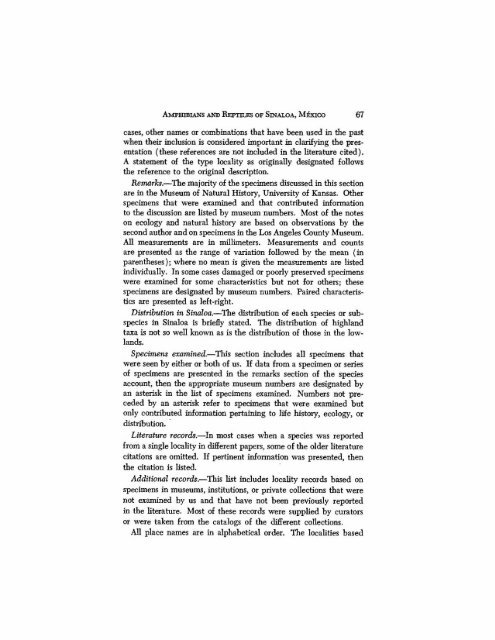The Amphibians and Reptiles of Sinaloa, Mexico - Smithsonian ...
The Amphibians and Reptiles of Sinaloa, Mexico - Smithsonian ...
The Amphibians and Reptiles of Sinaloa, Mexico - Smithsonian ...
Create successful ePaper yourself
Turn your PDF publications into a flip-book with our unique Google optimized e-Paper software.
AMPHIBIANS AND REPTILES OF SINALOA, MAxioo 67<br />
cases, other names or combinations that have been used in the past<br />
when their inclusion is considered important in clarifying the presentation<br />
(these references are not included in the literature cited).<br />
A statement <strong>of</strong> the type locality as originally designated follows<br />
the reference to the original description.<br />
Remarks.—<strong>The</strong> majority <strong>of</strong> the specimens discussed in this section<br />
are in the Museum <strong>of</strong> Natural History, University <strong>of</strong> Kansas. Other<br />
specimens that were examined <strong>and</strong> that contributed information<br />
to the discussion are listed by museum numbers. Most <strong>of</strong> the notes<br />
on ecology <strong>and</strong> natural history are based on observations by the<br />
second author <strong>and</strong> on specimens in the Los Angeles County Museum.<br />
All measurements are in millimeters. Measurements <strong>and</strong> counts<br />
are presented as the range <strong>of</strong> variation followed by the mean (in<br />
parentheses); where no mean is given the measurements are listed<br />
individually. In some cases damaged or poorly preserved specimens<br />
were examined for some characteristics but not for others; these<br />
specimens are designated by museum numbers. Paired characteristics<br />
are presented as left-right.<br />
Distribution in <strong>Sinaloa</strong>.—<strong>The</strong> distribution <strong>of</strong> each species or subspecies<br />
in <strong>Sinaloa</strong> is briefly stated. <strong>The</strong> distribution <strong>of</strong> highl<strong>and</strong><br />
taxa is not so well known as is the distribution <strong>of</strong> those in the lowl<strong>and</strong>s.<br />
Specimens examined.—This section includes all specimens that<br />
were seen by either or both <strong>of</strong> us. If data from a specimen or series<br />
<strong>of</strong> specimens are presented in the remarks section <strong>of</strong> the species<br />
account, then the appropriate museum numbers are designated by<br />
an asterisk in the list <strong>of</strong> specimens examined. Numbers not preceded<br />
by an asterisk refer to specimens that were examined but<br />
only contributed information pertaining to life history, ecology, or<br />
distribution.<br />
Literature records.—In most cases when a species was reported<br />
from a single locality in different papers, some <strong>of</strong> the older literature<br />
citations are omitted. If pertinent information was presented, then<br />
the citation is listed.<br />
Additional records.—This list includes locality records based on<br />
specimens in museums, institutions, or private collections that were<br />
not examined by us <strong>and</strong> that have not been previously reported<br />
in the literature. Most <strong>of</strong> these records were supplied by curators<br />
or were taken from the catalogs <strong>of</strong> the different collections.<br />
All place names are in alphabetical order. <strong>The</strong> localities based
















